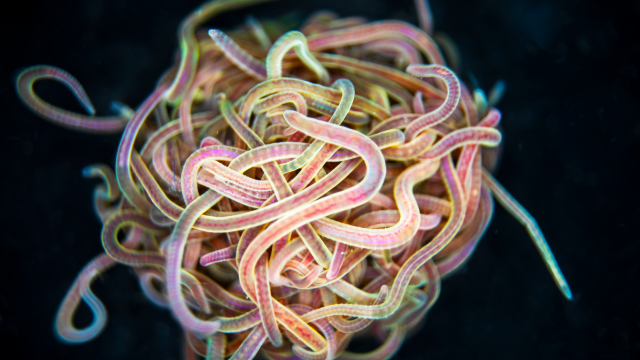A team of mathematicians and engineers is unravelling the wriggly mystery of blackworms; specifically, the researchers are trying to understand how the worms are able to disentangle even quicker than they (intentionally) intertwine.
California blackworms (Lumbriculus variegatus) come together to perform certain communal tasks. When they perceive a threat or are seeking to regulate their temperature or moisture, they’re able to disseminate in a matter of milliseconds.
These self-organising worm knots form in groups as small as 5 worms and as large as 50,000 writhing individuals. The team’s research on the worms’ movements was published today in Science.
“Actively shapeshifting topological matter is currently the stuff of science fiction,” said Saad Bhamla, an engineer at Georgia Tech and a co-author of the paper, in an institute release. “Imagine a soft, nonwoven material made of millions of stringlike filaments that can tangle and untangle on command, forming a smart adhesive bandage that shape-morphs as a wound heals, or a smart filtration material that alters pore topology to trap particles of different sizes or chemical properties.”
“The possibilities are endless,” Bhamla added.
To decipher the worms’ remarkable ability to come together and disassemble, the researchers used ultrasound imaging to produce a 3D reconstruction of the worms’ movements. They combined this reconstruction with theoretical analysis to produce a model of the worms’ mechanical movements.
Remarkably, the researchers found that most worms were in contact with other worms, and when any individual took an action, the surrounding worms acted in turn, in fractions of a second. Taking cues from their brethren, the worms functioned as a single unit to tangle and even more quickly disentangle.
“Their results predict a large space of tangling and untangling strategies,” wrote Eleni Panagiotou, a mathematician specializing in knot theory at Arizona State University, in an accompanying Perspectives article. “They also predict that there are stable tangle topologies that are not accessed by the worm tangles, which indicates a space of unexplored possibilities.”
“The generality of the model prompts the question of whether it can be applied to systems at different length and time scales,” Panagiotou added. “If so, the approach could give rise to new materials that markedly change their mechanical properties when their topology is modulated.”
Mother nature has plenty of lessons for technologists. Robots are designed to mimic the gripping capability of birds, and robot worms already exist and are used for biomedical purposes. The recent research could inform other wormlike robots, as well as tentacled gripping robots, one of which was revealed at Harvard University last year.
These self-organising blackworms may provide the backbone for future filamentous technologies.
